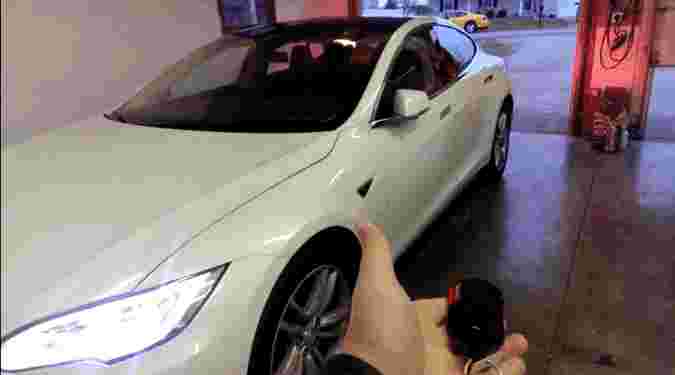Watch this Tesla car drive itself with new ‘Summon’ option
Ok, this is cool. The latest version of Tesla’s software actually allows drivers to get out of the car and let the Model S do all of the work, driving itself with just a tap of the key fob.

Called ‘Summon,’ the feature allows Tesla owners to let the car park and back itself out of parking spaces at will. If the car is connected to a garage door through the ‘HomeLink’ connection, the car will also be able to operate that all by itself. So if you’re really over driving the extra few feet inside your garage or you’d just rather have your car ready to go in the morning, the Model S uses the myriad of sensors and cameras already built into the car to get the job done with no driver involved.
Plus, it just looks cool. Like James Bond cool.
The new update, v. 7.1, also features new restrictions to the car’s semi-autonomous ‘Autopilot’ feature to maximize road safety — particularly ensuring that the car does not exceed five miles above a given speed limit, and that the person operating the car must be in the driver’s seat. For those of you brave enough to take your hands off the wheel, you can do so with more safety involved.
➤ Now the Model S can REALLY drive itself, Tesla pushes update v7.1 with “summoning” feature [Video] [Electrek]
Is the headphone jack for smartphones on its way out?
Near the end of 2015, rumors began circulating about the iPhone 7 ditching the 3.5mm jack in favor of using the Lightning connector to let people connect their headphones.

Apple hasn’t said anything about it yet. But two Android phone manufacturers, Motorola and LeEco , have already ditched the headphone jack in their latest handsets.
It’s an interesting development, because these devices aren’t squarely aimed at buyers looking to spend top dollar (LeEco’s new devices, the Le 2 and Le Max 2 are priced at Rs. 11,999 ($180) and Rs. 22,999($345) in India respectively).
So, unlike Apple, there’s a lot more at stake for these brands that will appeal to budget-conscious consumers who may not immediately be ready to say goodbye to 3.5mm audio gear.
Will other brands follow suit? And is this the end of the ubiquitous headphone jack? It’s hard to be sure at this point, for a couple of reasons.
LeEco’s president of R&D Liang Jun told The Verge that the reason his company decided to do away with the headphone jack for the Le 2 and Le Max 2 is that, “With the 3.5mm audio jack, the stereo sound was compromised due to poor sound channel separation and the sound quality was compromised due to a mismatch between phone and headphones.”
I haven’t yet had a chance to try these models or any USB-C-based headphones, so I can’t confirm this. But I’ve heard music on budget headphones with my Android device, as well as through professional studio monitor speakers, and the difference in quality is subtle at best. In daily use, I doubt there’s any significant bump in sound quality to be gained from switching to Lightning and USB-C gear.
Jun also noted that ditching the headphone jack and going USB-C only didn’t impact the manufacturing process or help LeEco save space in its phone design. In that case, what’s the real benefit to customers who almost certainly have a pair of 3.5mm jack-based headphones lying around?
To argue the other side, it’s possible that as battery technology and wireless protocols like Bluetooth improve , more people will eventually move on USB-C and Lightning based headphones or skip wired equipment altogether for Bluetooth gear.
What’s more important to note is whether other categories of devices follow suit. Laptop, portable gaming consoles and music players all have 3.5mm jacks, so it doesn’t make sense to have multiple pairs of headphones for each gadget.
Unless we see real benefits, like vastly slimmer phone designs, from the removal of headphone jacks, it’s hard to fathom the popular port disappearing from all phones any time soon. It can and probably will happen at some point, but not until we have an alternative that works as well across devices.
First flagship Ubuntu phone is now available to buy, but you probably won’t
Canonical has announced that the Meizu Pro 5 Ubuntu Edition is available to buy online for $369 from today.

Announced earlier in the year, the device offers up a not-inconsiderable 5.7-inch Corning Gorilla Glass 1080p HD display, 32GB of internal storage and a 21-megapixel Sony image sensor on the rear camera. Powering the handset along is a Samsung Exynos 7420 Octa-core processor, as you’d find in last year’s Samsung flaghip handsets, like the S6 and S6 Edge+.
Of course, the major selling point for anyone genuinely intrigued by the phone is the Ubuntu OS, which can take a little getting used to when coming from an Android device or iPhone. That’s not to say it’s not worth checking out, however,
Nonetheless, most of you probably won’t feel the need. You like your Android or Apple phone and don’t want to take the time to learn; that’s what Canonical is expecting anyway, so it won’t come as a huge surprise.
However, Ubuntu offers something only Microsoft can rival right now: a single platform vision of the future that could potentially make sense, and despite a lack of visible market traction, that’s not to be sniffed at.
